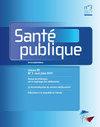L’addiction à internet, une réalité contemporaine au Bénin : analyse exploratoire des facteurs associés chez des étudiants du secteur médical et paramédical en 2022
IF 0.3
4区 医学
Q4 PUBLIC, ENVIRONMENTAL & OCCUPATIONAL HEALTH
引用次数: 0
Abstract
INTRODUCTION Nowadays, Internet addiction is a major concern due to the growing number of Internet users and the consequences associated with this addiction. PURPOSE OF THE RESEARCH In this study, we aimed to determine the prevalence of and factors associated with Internet addiction among health sciences students at the University of Abomey-Calavi. METHODS A cross-sectional study was conducted among 346 students from the Faculty of Health Sciences and the National Institute of Medical and Health Sciences at the University of Abomey-Calavi. Participants were selected using simple random sampling. Internet addiction was assessed using K. Young’s “Internet Addiction Test.” Logistic regression modeling was employed to explore factors associated with Internet addiction. The strength of the association was assessed using odds ratios; the confidence interval (CI) was 95%; and a p-value < 0.05 in the final model was considered significant. RESULTS The prevalence of Internet addiction was 31.8% (95% CI: [23.26% - 41.38%]). Factors associated with Internet addiction were the participant’s field of study, poor relationships with friends and family, communication difficulties, depression, and psychoactive substance consumption. CONCLUSIONS Evidence of Internet addiction exists among students in health sciences institutions in Benin. These findings can support the development of prevention and intervention strategies centered on addressing a public health issue that is still insufficiently recognized.网络成瘾--贝宁的当代现实:2022 年医科和护理专业学生相关因素的探索性分析
研究目的在这项研究中,我们旨在确定阿波美-卡拉维大学健康科学专业学生中网络成瘾的流行程度和相关因素。方法我们对阿波美-卡拉维大学健康科学学院和国家医疗与健康科学研究所的 346 名学生进行了横断面研究。研究人员通过简单随机抽样的方式选出。使用 K. Young 的 "网络成瘾测试 "对网络成瘾进行评估。采用逻辑回归模型探讨与网络成瘾相关的因素。结果网络成瘾的发生率为 31.8%(95% CI:[23.26% - 41.38%])。与网络成瘾相关的因素包括参与者的学习领域、与朋友和家人关系不佳、沟通困难、抑郁和精神活性物质消费。这些发现有助于制定预防和干预策略,以解决这一尚未得到充分认识的公共卫生问题。
本文章由计算机程序翻译,如有差异,请以英文原文为准。
求助全文
约1分钟内获得全文
求助全文
来源期刊

Sante Publique
PUBLIC, ENVIRONMENTAL & OCCUPATIONAL HEALTH-
CiteScore
0.40
自引率
33.30%
发文量
252
审稿时长
>12 weeks
期刊介绍:
La revue Santé Publique s’adresse à l’ensemble des acteurs de santé publique qu’ils soient décideurs,
professionnels de santé, acteurs de terrain, chercheurs, enseignants ou formateurs, etc. Elle publie
des travaux de recherche, des évaluations, des analyses d’action, des réflexions sur des interventions
de santé, des opinions, relevant des champs de la santé publique et de l’analyse des services de
soins, des sciences sociales et de l’action sociale.
Santé publique est une revue à comité de lecture, multidisciplinaire et généraliste, qui publie sur
l’ensemble des thèmes de la santé publique parmi lesquels : accès et recours aux soins, déterminants
et inégalités sociales de santé, prévention, éducation pour la santé, promotion de la santé,
organisation des soins, environnement, formation des professionnels de santé, nutrition, politiques
de santé, pratiques professionnelles, qualité des soins, gestion des risques sanitaires, représentation
et santé perçue, santé scolaire, santé et travail, systèmes de santé, systèmes d’information, veille
sanitaire, déterminants de la consommation de soins, organisation et économie des différents
secteurs de production de soins (hôpital, médicament, etc.), évaluation médico-économique
d’activités de soins ou de prévention et de programmes de santé, planification des ressources,
politiques de régulation et de financement, etc
 求助内容:
求助内容: 应助结果提醒方式:
应助结果提醒方式:


